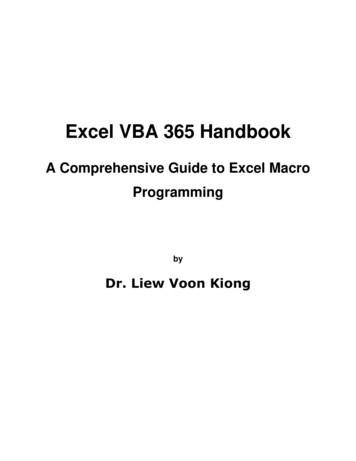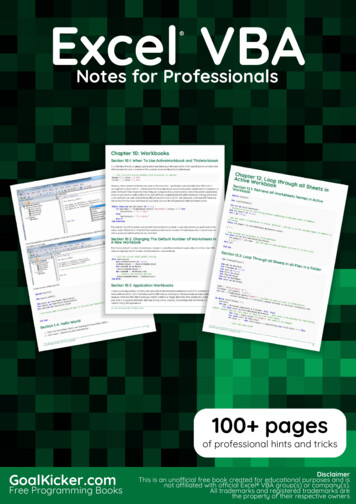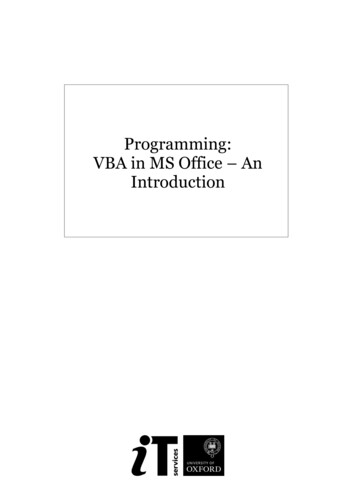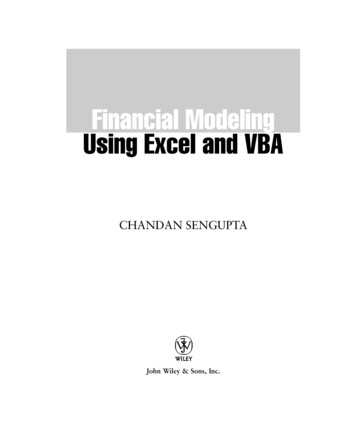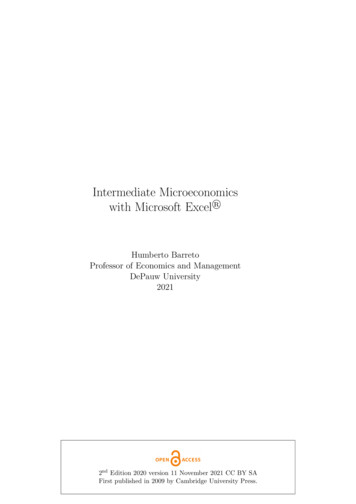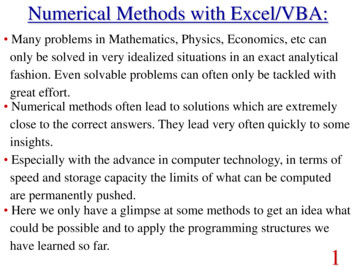
Transcription
Numerical Methods with Excel/VBA: Many problems in Mathematics, Physics, Economics, etc canonly be solved in very idealized situations in an exact analyticalfashion. Even solvable problems can often only be tackled withgreat effort. Numerical methods often lead to solutions which are extremelyclose to the correct answers. They lead very often quickly to someinsights. Especially with the advance in computer technology, in terms ofspeed and storage capacity the limits of what can be computedare permanently pushed. Here we only have a glimpse at some methods to get an idea whatcould be possible and to apply the programming structures wehave learned so far.1
Numerical Integration Recall:- Idea: approximate the integral by sums over trapezoidal areas :2
- Take the subdivision of the domain [a,b] to be evenly spaced: Trapezoid rule for integration: f( Let us write a module (program) for this:- Input: a lower integration limitb upper integration limitn number of subdivisionssome function f(x) which we want to integrate) f(a) f(b)-Output: approximate value for the integral (gets better the largern becomes)3
Sub Nint()a 0b 5n 100h (b - a) / nI h * (f(a) f(b)) / 2For m 2 To nI I f(a h * (m - 1)) * hNextRange("B3").Value IEnd SubPut the result onto the Excel sheet into the cell B3Function f(x)f x 4End Function4
Example 1:- The program gives: Example 2:- Generate the π by 4 Arctan(1). In VBA this is written as 4 *Atn(1).- The program yields:5
- So far we could have solved the integrals also analytically, but not thenext integral. Example 3:- How do we deal with the lower bound a 0? This is well definedanalytically, but the computer can not handle 0/0, if we don‘tspecify how to do that. Recipe: Just take the lower bound a to be avery small number, e.g.a 0.0000001.- The program yields:6
Example 4:- How do we deal with infinity? Introduce a cut-off at some valuelarge enough such that the mistake is small. This is possible becausethe integrant falls off sharply after certain values:- Compute instead:- The program gives:7
Different types of methods:- Simpson‘s 1/3 rule (based on three adjacent points):- Simpson‘s 3/8 rule (based on four adjacent points):- Runge-Kutta methods, Monte Carlo integration, · Here we do not derive these rules, but just take them as facts.See a different course on numerical methods for details.- Let us implement the Simpson‘s 3/8 rule as a user defined function.- Implement the Simpson‘s 1/3 rule in Labsession 3.8
Function Nintff(a, b, n)h (b - a) / nI 0For m 1 To n - 2 Step 3I I (f(a h*(m-1)) 3* f(a h* m) 3* f(a h*(m 1)) f(a h*(m 2)))NextNintff I * h * 3 / 8End Function Example 1:· A problem here is to find a good cut-off for the upper limit. b 10 ?9
- Compare different integration methods:i) open a worksheet· In this example we introduce an additional error though thecut-off.· When the subdivision of the interval is large enough the threemethods are almost equally good.10
Limitations:- The speed of the computer.- The accuracy of the numerical method used. (In principle thereexist procedures to estimate the errors made.)- The accuracy of the computer, i.e. in computing functions usedin the program and variables employed such as single or doubleprecision.- Various other approximations such as division by zero, cut-offsfor lower and upper bounds etc. There exist different types of numerical methods for othermathematical problems, such as solving polynomial equations,solving differential equations etc. Some methods are implemented in Excel as Built-in functions:11
Goal Seek Goal seek is a numerical routine implemented in Excel as abuilt-in function. It can be used to solve equations. Usage: select Data What if analysis goal seek- Set cell contains the left hand side ofan equation you want to solve- To value contains the RHS of the equation- By changing cell contains the variableof the equation Disadvantage: You have to guess a value near the answer. Example: Solve the equation: 2x2-9x-5 0(We expect to find: x1 -1/2 and x2 5 )- Type into the cell C3: 2*B3 2-9*B3-5- Type into the cell C4: 2*B4 2-9*B4-512
- Type into the cell B3 some starting value, e.g. -10- open the Goal Seek dialog box and fill in- OK- The cell B3 and C3 have changed to -0.5 and 1.912E-07- Repeat this process for the cells C4 and B3 to find the othersolution. (You need a new guess for the starting value.) A more sophisticated method is the Excel Solver.13
Numerical Methods with Excel/VBA: Many problems in Mathematics, Physics, Economics, etc can only be solved in very idealized situations in an exact analytical fashion. Even solvable problems can often only be tackled with great effort. Numerical methods often lead to so

![[MS-VBAL]: VBA Language Specification - Framework](/img/22/ms-vbal.jpg)
